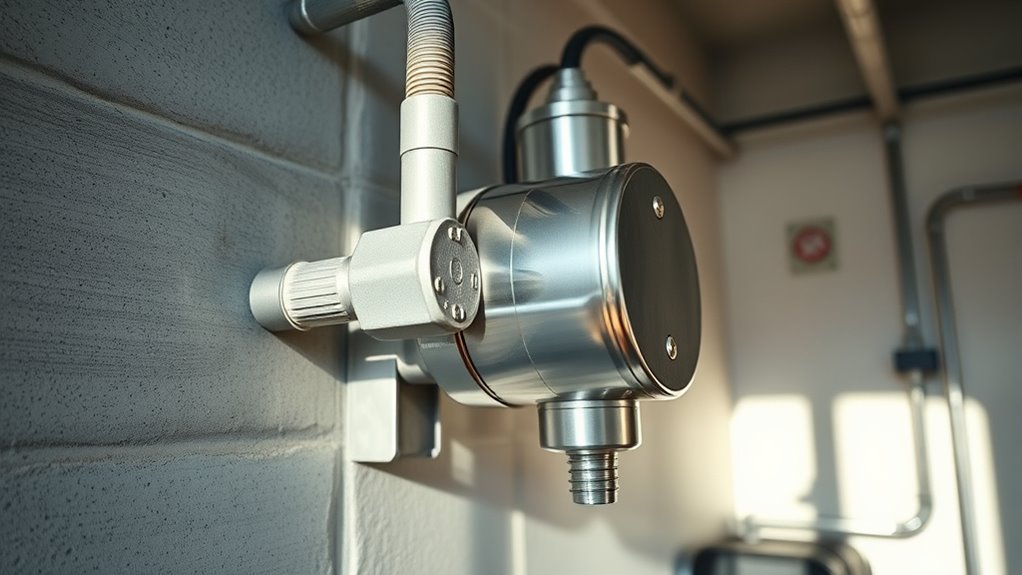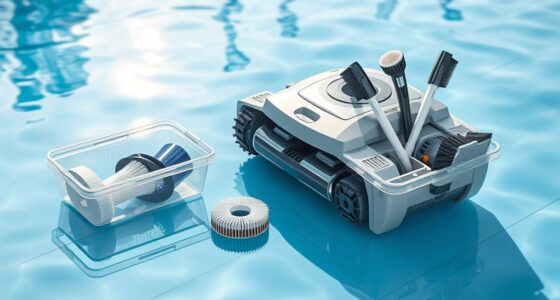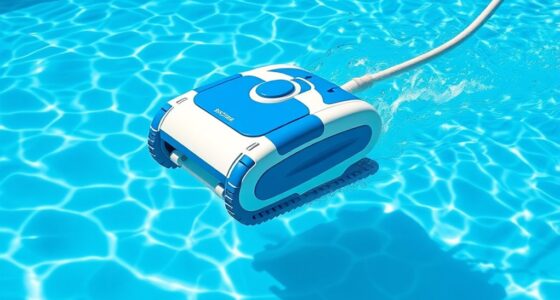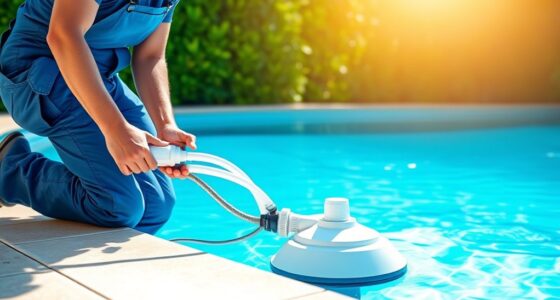If you notice weak water flow from fixtures, longer fill times, or have to use more water for daily tasks, a booster pump might be needed. This is especially true if you live in a tall building or experience constant pressure fluctuations. Before deciding, consider your current system’s status and potential causes of low pressure. To learn how a booster pump can help and what options you have, keep exploring further.
Key Takeaways
- Low water pressure causing weak flow and longer fill times indicates a booster pump may be needed.
- Multi-story homes or tall buildings often require a booster pump to maintain consistent pressure across all floors.
- Signs like increased water usage for rinsing or persistent plumbing issues suggest insufficient flow, warranting a pump.
- Fluctuating or unreliable water pressure can be stabilized with a booster pump, especially in off-grid or variable demand scenarios.
- If system maintenance or plumbing layout results in uneven flow or frequent pipe issues, installing a booster pump can improve performance.
Signs That Indicate Low Water Pressure
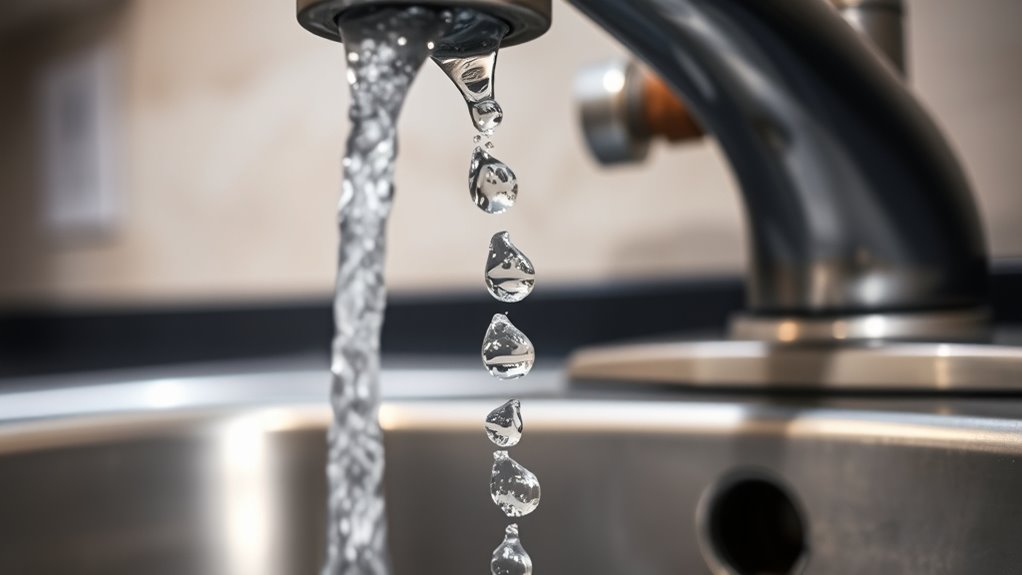
Low water pressure can often be subtle at first, but recognizing the signs early can save you time and inconvenience. If you notice your faucets or showerheads deliver a weaker flow, it’s a clear warning sign. Low pressure can lead to increased water usage as you try to rinse or wash thoroughly, which affects water conservation efforts. Persistent problems may indicate a need for plumbing maintenance, preventing larger issues down the line. You might also see uneven water flow from different fixtures or longer filling times for your bathtub or dishwasher. Addressing these signs promptly helps maintain efficient water use and extends the lifespan of your plumbing system. Staying attentive to changes in water flow ensures you catch problems early and keep your home functioning smoothly. Incorporating comfort solutions for plumbing fixtures can improve water efficiency and overall home comfort.
Common Causes of Inconsistent Water Flow
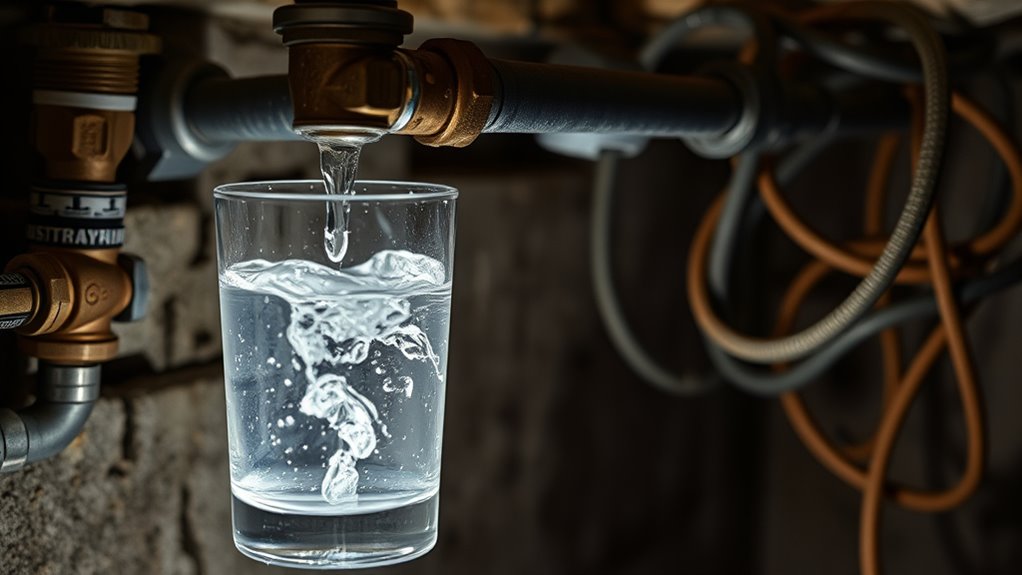
Have you ever noticed some fixtures delivering strong water flow while others sputter or trickle? Inconsistent flow can stem from several issues. Water filtration problems might cause blockages, reducing pressure in certain outlets. Over time, pipe expansion from temperature changes can create gaps or leaks, disrupting steady flow. Sediment buildup inside pipes or fixtures can restrict water movement, leading to sputtering. Additionally, if your plumbing system isn’t properly maintained, corrosion or mineral deposits may narrow pipes, causing fluctuations. Changes in water demand or pressure from the main line can also contribute. Regular pipe maintenance can help prevent some of these issues and restore steady, reliable water flow throughout your home. Ensuring your water system is well-maintained and free of mineral deposits can significantly improve water flow consistency. Furthermore, implementing automation in plumbing systems can help monitor and manage pressure variations more effectively. Understanding how plumbing system components interact can also aid in diagnosing persistent flow issues, especially when considering the impact of mineral buildup on flow performance.
How a Booster Pump Works to Improve Water Pressure
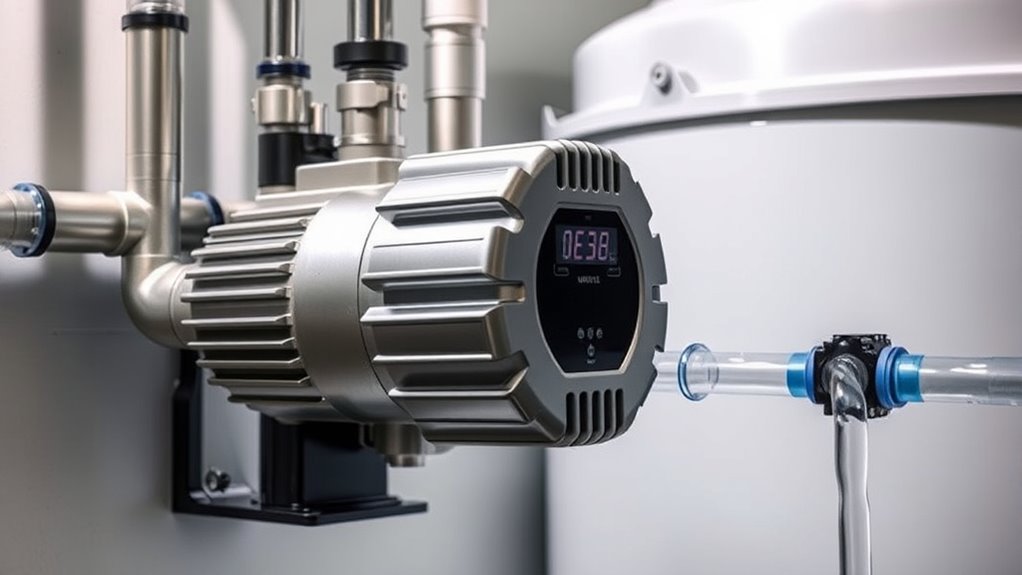
A booster pump enhances water pressure by actively increasing the flow rate as water moves through your plumbing system. It works by drawing water from your main supply and pushing it with greater force through your pipes, ensuring better flow to fixtures. This boost not only improves overall pressure but also supports water filtration systems that depend on steady flow to function effectively. The type of pipe materials in your plumbing can influence how well a booster pump performs; rigid materials like copper or PEX can handle increased pressure better than fragile ones. Proper Kia Tuning of your water system can help optimize pump performance and longevity. Additionally, understanding the contrast ratio in your home theater setup can influence how visual information is perceived, similar to how consistent water pressure ensures optimal function. By maintaining consistent pressure, a booster pump helps you avoid issues like low water flow and ensures your water filtration system operates efficiently, providing you with reliable, high-quality water throughout your home. Regular pressure regulation can further enhance the performance and lifespan of your pump, preventing potential damage caused by over-pressurization. Implementing pressure gauges can help monitor system performance and detect irregularities promptly. Ensuring proper system calibration is essential for maintaining optimal operation and preventing system strain.
Situations When a Booster Pump Is Necessary

If you notice consistently low water pressure or long wait times for water to reach your fixtures, a booster pump might be needed. Elevated building heights or multi-story homes often require additional pressure to guarantee reliable flow. Recognizing these situations helps you determine when a booster pump can make a real difference. For those interested in sustainable solutions, integrating electric power generation with bike generators can sometimes supplement energy needs in off-grid scenarios. Additionally, understanding your water pressure requirements can help you select the appropriate pump size and ensure optimal system performance. Being aware of your pressure fluctuations can also help identify when a booster pump is most beneficial for maintaining consistent water flow, especially in systems that incorporate protective styling benefits. Regular monitoring of your water pressure can further prevent ineffective purification issues caused by insufficient flow or pressure drops.
Low Water Pressure
When water pressure in your home drops to unsatisfactory levels, a booster pump often becomes essential to restore adequate flow. Low water pressure can result from factors like pipe material, which affects flow efficiency, or high water demand during peak times. If your pipes are made of materials prone to buildup or corrosion, water flow slows, making a booster pump necessary. Additionally, conserving water by reducing usage may not be enough if the system’s design or pipe condition restricts flow. A booster pump helps increase pressure, ensuring consistent water flow throughout your home. Understanding water system components and the overall water system can help identify when a booster pump is needed. For example, knowing the pressure regulation mechanisms in place can assist in determining whether a booster pump will effectively address your pressure issues. Installing a booster pump guarantees reliable water pressure, no matter the underlying causes. Recognizing water demand patterns can also help determine if a booster pump will provide the necessary improvements.
Long Water Runs
Long water runs in your home can considerably reduce water pressure, especially when pipes extend over large distances. When water travels a long way, pressure drops, making it hard to get steady flow at fixtures. A booster pump can help maintain consistent pressure, ensuring you get sufficient flow without waiting. Also, long runs can impact water quality, as stagnation or sediment buildup may occur, so regular pump maintenance is essential. If you notice inconsistent pressure or water quality issues after long runs, a booster pump might be necessary. It keeps water moving efficiently and preserves pressure throughout your home. Understanding water pressure is key to diagnosing when a booster pump is truly needed. Additionally, pipe length plays a significant role in pressure drop, so considering the entire plumbing layout is important when evaluating the need for a booster pump.
Elevated Building Heights
Elevated building heights can challenge your plumbing system by reducing water pressure at fixtures. When your home or building is tall, gravity causes water to lose pressure before reaching upper floors. This often leads to weak water flow, making daily tasks frustrating. Installing a booster pump ensures consistent pressure across all levels, supporting water conservation by preventing overuse caused by low pressure. Proper plumbing maintenance also helps identify pressure issues early, avoiding damage to pipes and fixtures. If you notice inconsistent water flow or low pressure upstairs, a booster pump might be necessary to maintain ideal performance. Addressing these height-related challenges keeps your water system efficient, saves water, and reduces the need for frequent plumbing repairs.
Assessing Your Home’s Water System Before Installing
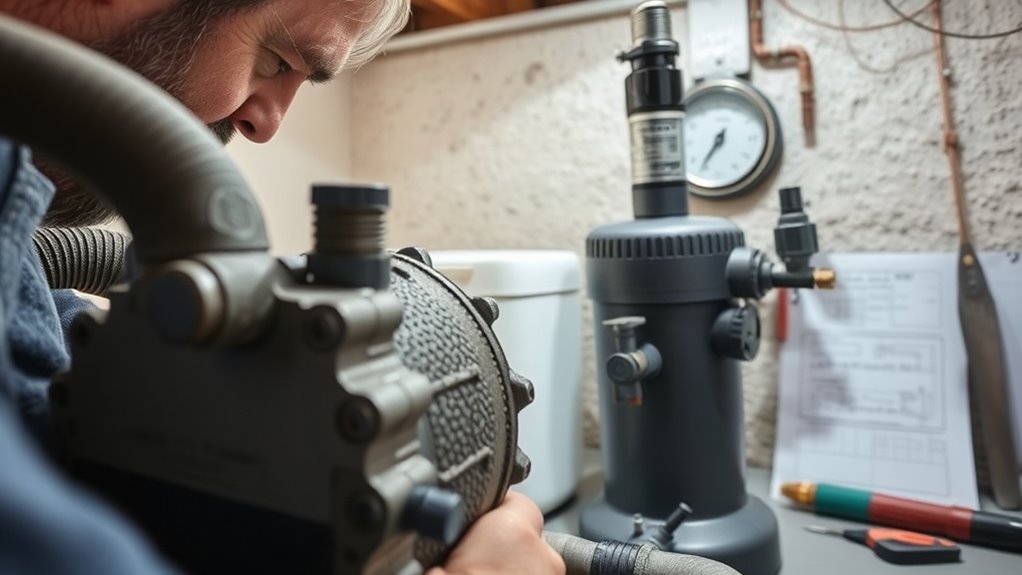
Before installing a booster pump, it’s essential to evaluate your home’s existing water system to guarantee compatibility and effectiveness. Check your current water pressure and flow rate to see if they meet your needs. Consider how your household uses water, including garden irrigation and running a septic system, which can demand consistent pressure. Inspect your pipes for any leaks or blockages that could affect performance. Think about whether your water source is reliable and how much demand your household places on it during peak times. Lastly, assess if your current pump setup is sufficient or if upgrades are necessary to prevent issues down the line. Taking these steps ensures your system will work smoothly with the new booster pump, avoiding unnecessary costs or complications.
Types of Booster Pumps Available on the Market
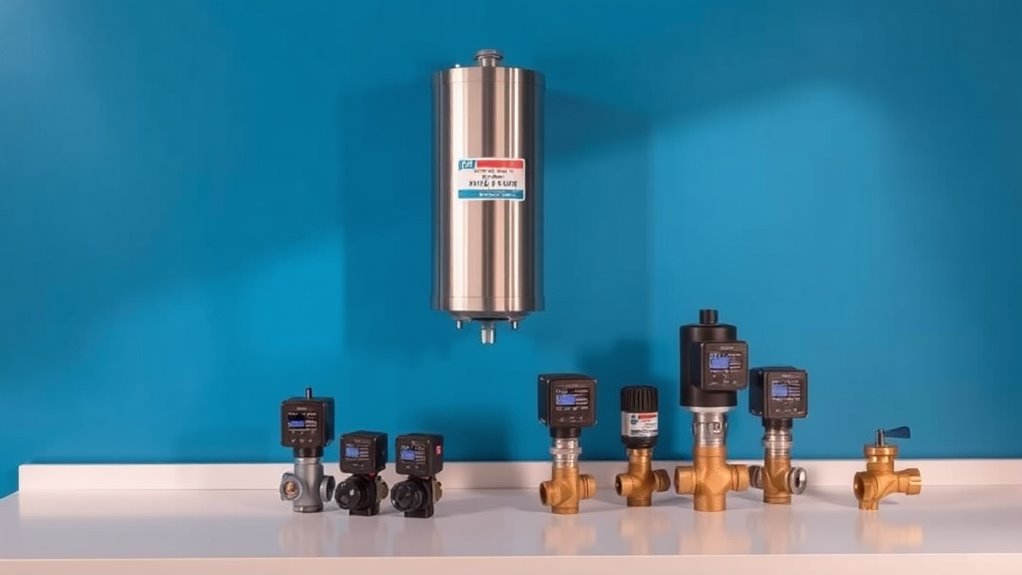
There are several types of booster pumps you can choose from, each suited to different needs. Centrifugal booster pumps are common for general use, while positive displacement models provide consistent pressure for specific applications. Submersible pump varieties are ideal when space is limited or when the pump needs to operate underwater.
Centrifugal Booster Pumps
Are centrifugal booster pumps the most versatile option for boosting water pressure? Likely, yes. They’re widely used in applications like aquifer recharge and water treatment, thanks to their efficiency and reliability. These pumps work well in scenarios requiring high flow rates and moderate pressure increases. You can find them in residential systems or industrial setups, handling large volumes of water smoothly. Plus, they’re easy to maintain and adapt to different needs. Their versatility makes them suitable for boosting water pressure in municipal pipelines or irrigation systems. When choosing a pump, consider factors like flow rate, head height, and compatibility with your water source. Centrifugal booster pumps, with their robust design, are often the best fit for many water supply challenges.
Positive Displacement Options
Have you considered the positive displacement pumps available for boosting water pressure? These pumps deliver a constant flow regardless of pressure changes, making them ideal for precise applications. They’re highly efficient for water conservation because they use less energy to maintain steady pressure. Plus, their simple design means pump maintenance is straightforward, reducing downtime and repair costs. Common types include diaphragm, piston, and rotary pumps. Each offers reliable performance in situations where consistent pressure is critical. Unlike centrifugal pumps, positive displacement options handle varying flow demands without losing efficiency. If you need a pump that’s easy to maintain and conserves water, these options might be perfect for your needs. Just remember, proper maintenance guarantees they operate smoothly and last longer.
Submersible Pump Varieties
Submersible pumps come in several varieties, each designed to suit different boosting needs and installation environments. You can choose based on factors like water quality, flow rate, and space constraints. For instance, some models are refined for water filtration, guaranteeing clean water delivery, while others focus on high flow rates for larger systems. When selecting a submersible pump, consider ease of pump maintenance—easy access can save you time and money. Here are some common types:
- Vertical turbine pumps for high-volume applications
- Single-stage submersible pumps for small homes
- Multi-stage models for increased pressure
- Compact pumps for tight spaces
- Pumps with built-in filtration features for cleaner water
Knowing your pump type helps assure optimal performance and longevity.
Installation Considerations and Potential Challenges

Installing a booster pump requires careful planning to guarantee ideal performance and longevity. You need to contemplate factors like proper placement, securing the pump against vibrations, and ensuring accessible maintenance. Pay attention to corrosion prevention by selecting corrosion-resistant materials and protecting connections from moisture. Energy efficiency also matters; choose a pump with an appropriate size and features like variable speed drives to reduce power consumption. Here’s a quick overview:
| Consideration | Importance | Tip |
|---|---|---|
| Proper Location | Prevents damage and noise | Install indoors or sheltered area |
| Corrosion Prevention | Extends pump lifespan | Use corrosion-resistant materials |
| Power Efficiency | Reduces operating costs | Opt for energy-efficient models |
Addressing these challenges ensures your pump operates smoothly and lasts longer.
Cost-Benefit Analysis of Using a Booster Pump
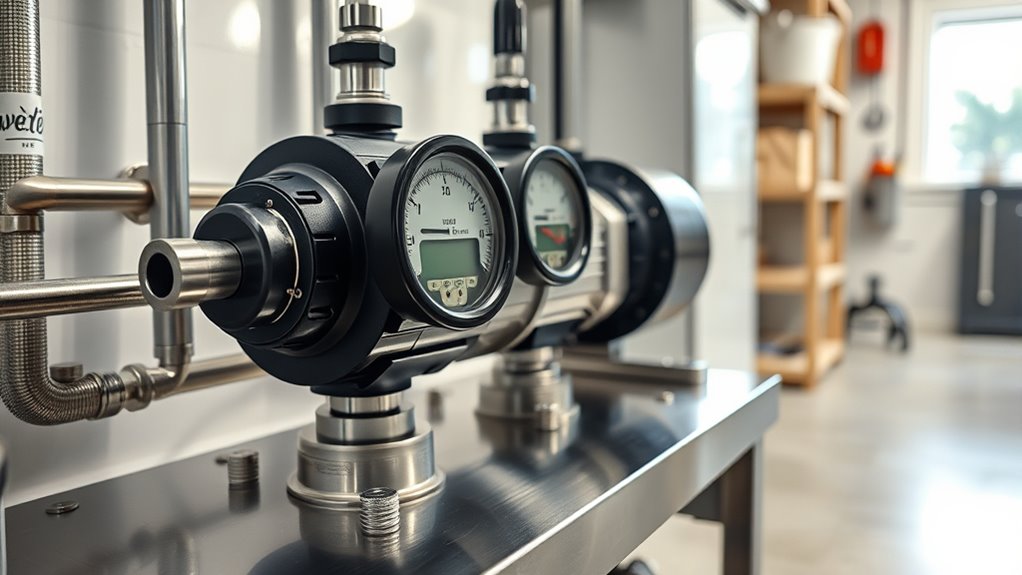
A thorough cost-benefit analysis of using a booster pump helps you determine whether the investment will pay off over time. While it can improve water pressure, consider the impact on water softening and pipe corrosion. A booster pump might reduce pipe wear caused by low pressure, saving you repair costs. However, increased water flow could accelerate pipe corrosion if your water isn’t properly softened. The initial purchase and installation costs are important, but so are ongoing maintenance expenses.
- Improved water pressure enhances daily comfort and appliance efficiency
- Potential reduction in pipe damage and repair costs
- Risk of increased pipe corrosion if water isn’t softened properly
- Energy consumption and operational costs add up
- Long-term savings depend on how well you maintain your system
Alternatives to Boosting Water Pressure
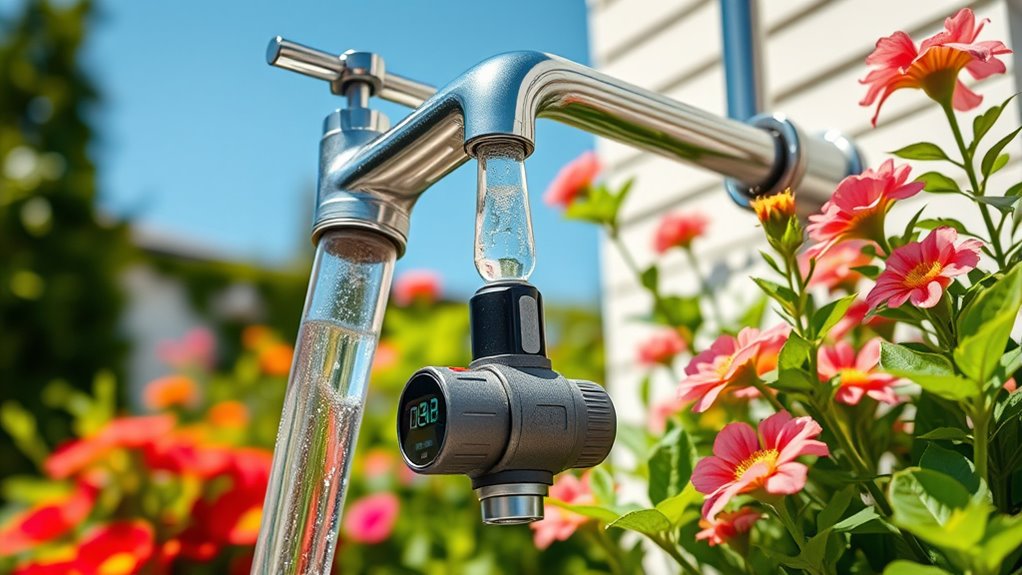
Instead of relying solely on booster pumps, exploring alternative solutions can often address water pressure issues more efficiently. One effective method is practicing water conservation, which reduces demand and eases pressure problems. Installing pipe insulation can also prevent heat loss and minimize pressure drops caused by temperature fluctuations. Check for leaks in your plumbing, as they can considerably lower water pressure; repairing leaks restores flow without extra equipment. Additionally, consider adjusting your home’s main shutoff valve or pressure regulator to optimize flow. These strategies are often more cost-effective and environmentally friendly than installing a booster pump. By conserving water and maintaining your pipes properly, you can improve water pressure naturally and sustainably, avoiding unnecessary expenses and energy consumption.
Frequently Asked Questions
How Long Does It Take to Install a Booster Pump?
Installing a booster pump typically takes a few hours, depending on pump size and your plumbing setup. You’ll need to follow installation steps like turning off water, selecting the right pump size, and connecting it properly. If you’re comfortable with basic plumbing, you might finish quicker. Otherwise, hiring a professional can guarantee proper installation, saving you time and preventing future issues. Overall, plan for a couple of hours for a smooth process.
Are Booster Pumps Noisy During Operation?
Booster pumps can be noisy during operation, but noise levels vary depending on the model. Some are designed with noise reduction features, making them quieter, while others may produce more sound. Generally, higher-quality pumps offer better durability and tend to operate more smoothly with less noise. If noise is a concern, look for pumps labeled as quiet or with sound insulation. Proper installation also helps minimize operational noise.
Can a Booster Pump Increase Pressure for Multiple Fixtures Simultaneously?
A booster pump can indeed elevate pressure for multiple fixtures at once, helping maintain flow consistency. It works by enhancing water pressure throughout your system, reducing pressure fluctuations when multiple taps are in use. This ensures steady water flow and prevents drops in pressure during peak usage. You benefit from reliable water delivery across all fixtures, making your everyday activities smoother without the annoyance of inconsistent water flow.
What Maintenance Is Required for Booster Pumps?
You might find maintenance surprises with your booster pump, but regular checks keep it running smoothly. To extend its pump lifespan, inspect for wear and tear, and clean filters often. Corrosion prevention is key, so make certain the pump is protected from moisture and corrosion-prone environments. Regular lubrication and monitoring pressure levels also help prevent unexpected breakdowns. Staying proactive saves you money and keeps your water pressure consistent.
How Often Should I Inspect My Water System After Installation?
After installing your water system, you should inspect it regularly—at least once every three to six months. Check the water filtration system for clogs or sediment buildup, and guarantee pipe materials are free from leaks or corrosion. Regular inspections help maintain ideal flow and water quality, preventing issues before they become costly. Keeping an eye on these components ensures your water system stays efficient and safe for everyday use.
Conclusion
So, think you need a booster pump? Unless you enjoy the thrill of waiting forever for your shower to warm up or playing water roulette, it’s probably time to contemplate one. But hey, who needs reliable pressure when you can embrace the chaos of inconsistent flow? Just remember, installing a booster pump might turn your water woes into a minor investment—unless you’re secretly auditioning for a plumbing horror story. Cheers to better water, or chaos—your call!
